Every year, more solar inverter brands arrive on the Australian market. But which one should you choose for your solar power system?
I think the best people to answer this question are the people that have to install, commission, maintain and support those inverters every day: the solar installers.
SolarQuotes Installers’ Choice Awards For Inverters: 2022
Every year we ask the installers in the SolarQuotes Network what solar inverter brand they’d put on their own house in 2 scenarios:
- If money is no object
- If every dollar counts
We collate the results in our Installers’ Choice Awards to give you some guidance as to the best inverter brands available in Australia – whether you want the best-of-the-best or simply a great, budget system.
The awards are in their second year, and here are the results for 2022:
Note: Choosing good brands is very important when buying solar. But you must still ensure the system is well installed. If you choose an installer through SolarQuotes, we guarantee you’ll get a good installation.
The latest evaluation and ranking for best solar inverters in 2023 have been compiled in a comprehensive article, which is an essential read for those wanting to stay updated on the best-performing solar inverters in 2023.
Best High-End Solar Inverters in Australia (Money No Object):
First, we asked the installers:
What solar inverter brand would you put on your own house if money was no object?
Here’s what they told us their favourite ‘high-end’ brands are:
Best Inverter – First Place: Fronius (34% of votes)
Taking the gold medal for the second year in a row is Austrian manufacturer, Fronius.
Fronius Primo solar inverters and Gen 24 hybrid models have long had a great reputation in Australia for:
- Build quality
- Reliability
- Ease of installation
- Robust MPPT software (i.e. they can handle multiple orientations on one input surprisingly well)
They are not cheap – typically adding at least $1,000 to your system price compared to a good budget inverter – but many installers are wary of using anything else.
I know one solar engineer who likes Fronius so much they even had the Fronius logo tattooed on their calf.
There are 6,033 Fronius inverter reviews on SolarQuotes at the time of writing with an average score of 4.8 stars. One issue flagged in those reviews is that the Primo cooling fans can be noisy. Thankfully the newer Gen 24 hybrid inverters run much quieter.
“Great so far…Be warned though the unit can be quite noisy as the cooling fan spools up though out the day.”
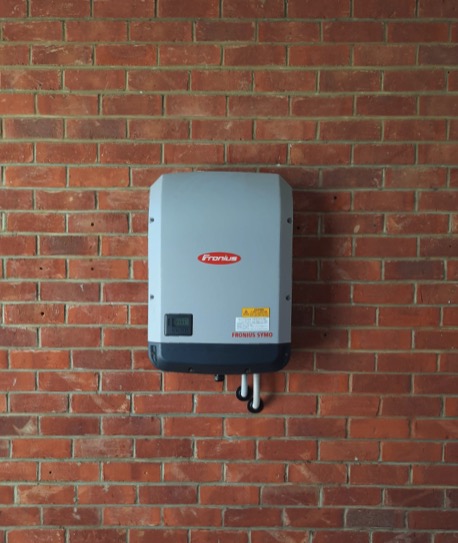
Fronius Primo inverter installed by Goliath Solar & Electrical
Best Inverter – Second Place: Enphase (29% of votes)
Enphase moves up one place in 2022 to take silver after taking bronze in 2021.
If you want Enphase, you’ll need one microinverter per panel and one Envoy base unit on the wall by your switchboard. Enphase is the generally most expensive solution – expect to pay at least $175 per microinverter, per panel for their IQ7 series.
A trend in Enphase’s favour is the increasingly larger panel wattages. With 400+ watt panels becoming common, you need fewer panels in your system and fewer microinverters.
Advantages of Enphase microinverters include:
- Fault tolerance
- Individual panel monitoring
- Individual panel optimisation
- Almost no limits on roof complexity
And you can drive over them in a forklift:
Australian Enphase owners are a happy bunch, giving an average of 4.8 stars from 1,376 Enphase microinverter reviews on SolarQuotes.
Best Inverter – Third Place: SolarEdge (17% of votes)
SolarEdge drop from silver in 2021 to bronze in 2022 with their per-panel optimiser and string inverter solution.
The clear favourite SolarEdge inverter model with installers was the new Energy Hub hybrid inverter with a built-in consumption meter. The Energy Hub is also compatible with the new SolarEdge Battery when it is released in Australia later this year.
SolarEdge owners in Australia rate the brand 4.7 stars from 1,472 SolarEdge inverter reviews. Reviewers commonly praise the SolarEdge monitoring app:
“The associated app is excellent and we have been able to better manage our electric use by checking solar power being produced and running appliances accordingly.”
But there are also multiple recent complaints about the slow response of SolarEdge’s Australian warranty support:
“Worked well initially, but suddenly stopped after about 8 months. Has been out of action now for over 7 weeks, with no response from SolarEdge despite numerous attempts by me and the installer.”
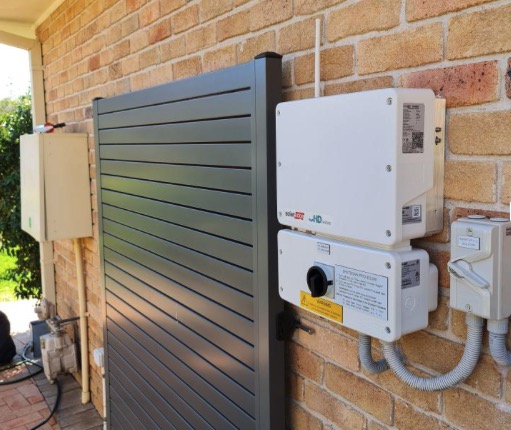
SolarEdge Inverter installed by PTE Solar & Electrical
Best Budget Solar Inverters in Australia (Every Dollar Counts):
We also asked the installers:
What solar inverter brand would you put on your own house if money was tight and every dollar counts?
Here are their favourite budget brands:
Best Budget Inverter – First Place: Sungrow (33% of votes)
Sungrow romped to victory for the second year in a row, winning more than double the votes of any other brand in this category.
Sungrow makes high quality, reliable, well-supported and feature-packed inverters that cost about $1,000 less than the equivalent Fronius.
Australian reviews of Sungrow inverters rate them at 4.6 Stars from 1,553 reviews.
Some reviews criticise the Sungrow monitoring app, the interface of which I also find clumsy. But the good news is Sungrow were the first to integrate their hardware with the Australian Solar Analytics app, which is a much better experience.
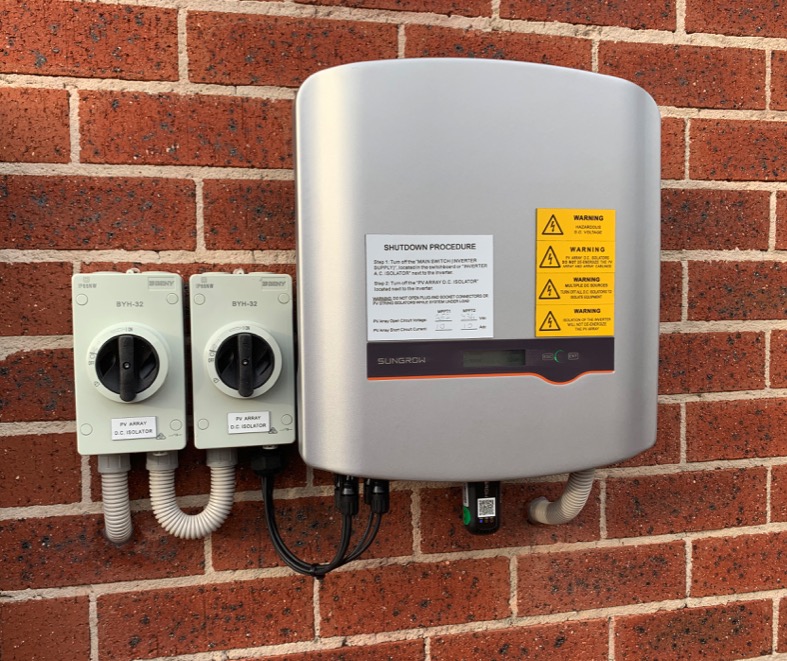
Sungrow inverter installed by Clipsal Solar
Best Budget Inverter – Second Place: GoodWe (15% of votes)
Moving up a spot from third place in 2021 to second in 2022 is GoodWe, who just seems to get better and better. As well as their own brand, GoodWe makes inverters for Redback and General Electric (GE); among others.
GoodWe’s most recent ‘MS’ solar inverter has 3 MPPTs compared to the 2 MPPTs in most, and has rave reviews from at least one expert installer. Three MPPTs allow for more complex roofs, stepping on the toes of the much more expensive Enphase.
GoodWe inverter reviews score 4.6 stars from 955 reviews on SolarQuotes at time of writing. But be aware a number of those reviewers warn high ambient temperatures cause GoodWe inverters to significantly derate. For example:
“It is important to keep the inverter away from heat exposure. On hot days the output will be restricted as to not overheat the inverter. We had a number of 40+ C days and the capacity was significantly reduced between approx 10am-3pm.”
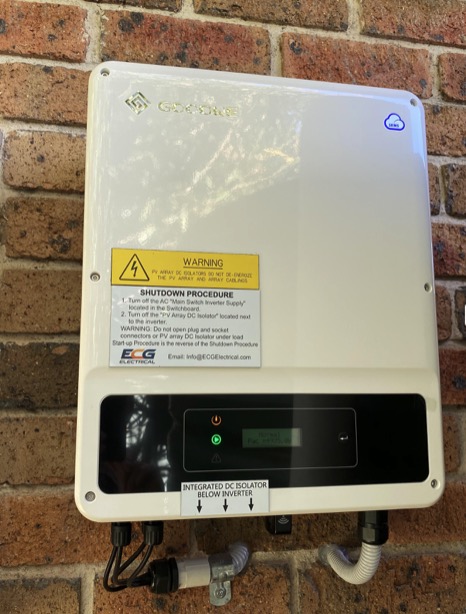
GoodWe inverter installed by ECG Electrical
Best Budget Inverter – Third Place: Fronius (15% of votes)
Fronius – winner of Best Inverter for 2 years running, also gets a podium for Best Budget Inverter for 2 years in a row.
Considering Fronius don’t make a budget inverter, this result only goes to show that many good Australian installers love Fronius so much they can’t countenance the thought of installing anything else – even when on a tight budget. Great result for a great brand.
So, those are the results for inverters – now discover the best home batteries in 2022 as voted by Australian solar installers, and also the voting results for the best solar panel brands in 2022.

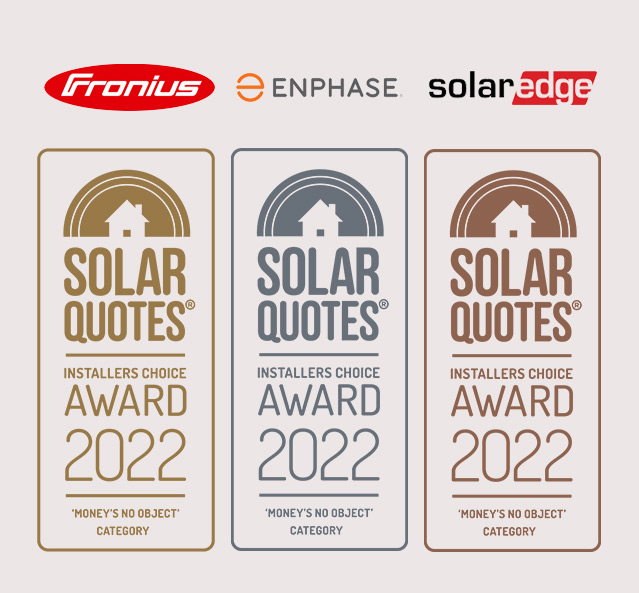
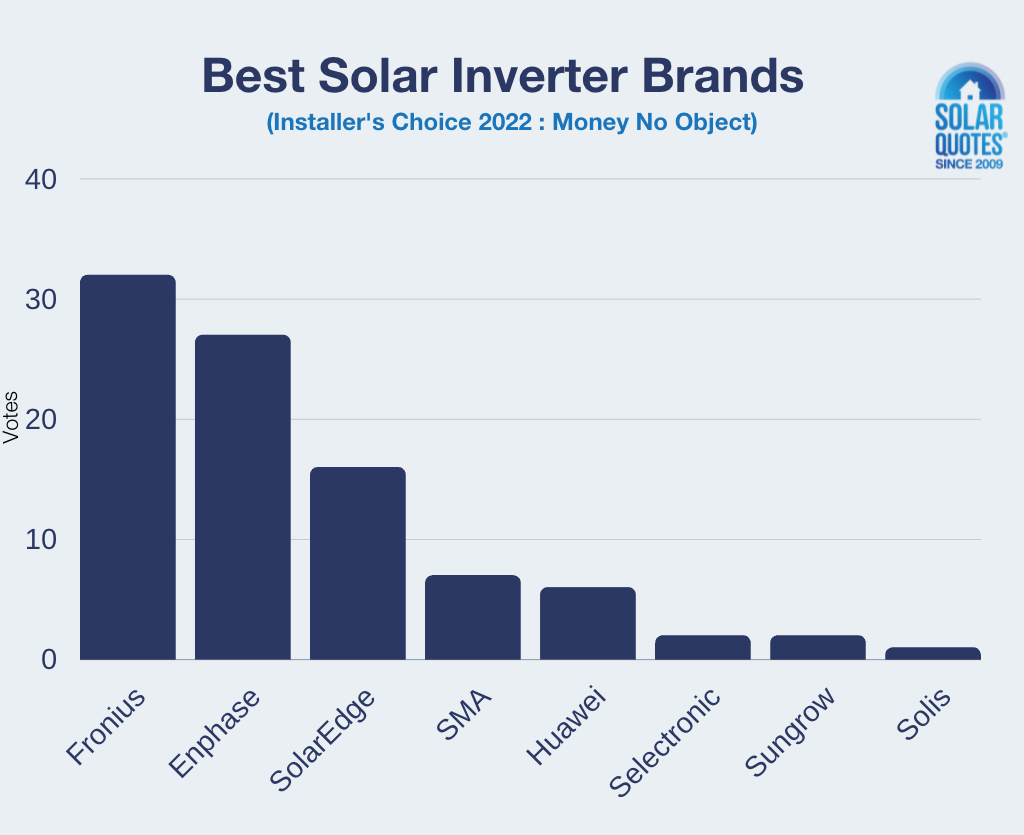

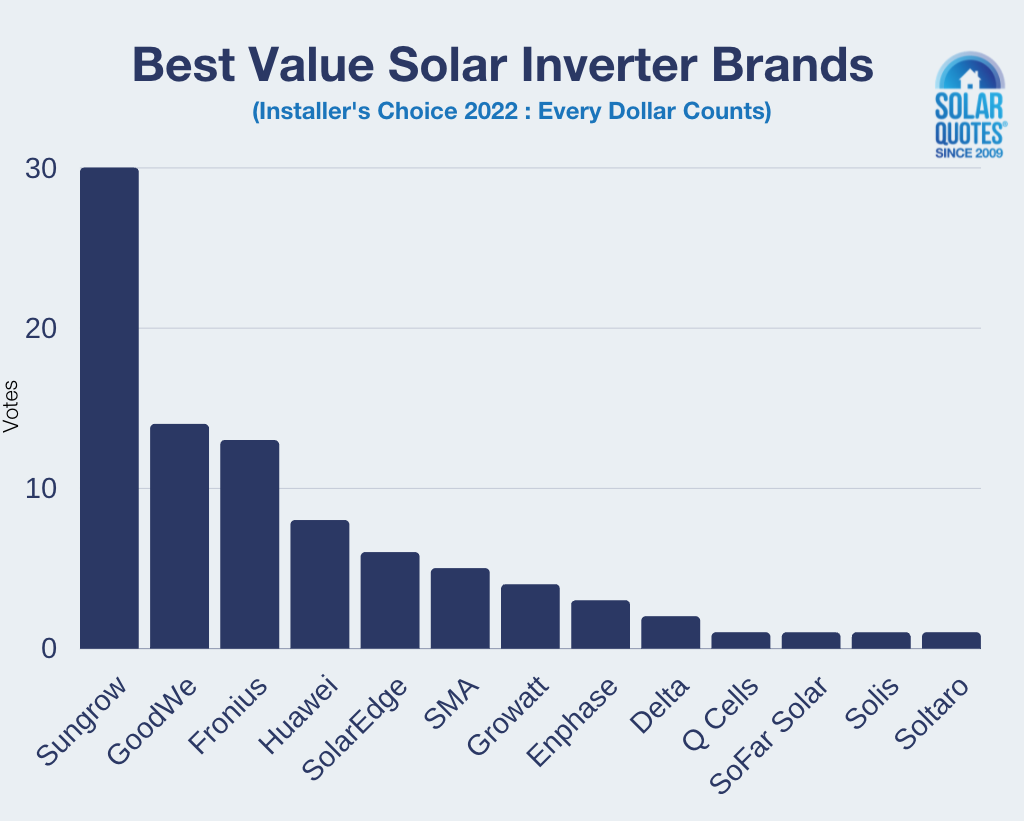
 RSS - Posts
RSS - Posts



Tattoo on his calf? So the tattoo will expand as the calf grows. Smart!
Solax does not get a mention ??? Reasons?
Because they’re rubbish?
Why are they rubbish?
Garth, the results are simply what installers have told us. Finn gave a possible reason, but we didn’t ask installers specifically about Solax so we don’t know why it wasn’t mentioned.
It’s really not good enough for Finn to say ” because they are rubbish”.
I think that his blogging requires a bit more finesse while providing informative comments.
For Finn to say that SolaX is just rubbish hints at the current Aussie attitude to China…which simply copies the US attitude of lets hit them then squash them flat.
Finn’s comment calls for some useful comments from those who have have both good and bad experiences with SolaX hardware.
Must say, I am disappointed to see SMA with so few votes. Are their inverters no longer very good? Have quality issues snuck in?
My first solar install – a 3kw system installed in October 2012 with a 3kw SMA inverter is still working at what looks like 100% output. 22kwh on a sunny December day in 2012 and 22kwh on a sunny December day in 2021. Yesterday it gave me 17kwh and there was a few clouds about during the day.
My second install (on the same house) is also using an SMA inverter, this is a 5kw inverter with 6.6kw of panels in East/West orientation, installed in October 2017. Also performing just as well today as they did when first installed. This system produces roughly double the output of the smaller system that faces due north.
I am very happy with my two SMA inverters, can’t praise them enough for their long term performance.
Agreed, SMA is great. But they seem to be less popular in Australia these days. The whole Made-In-China/Not-Made-In-China and Zeversolar debacle didn’t help.
Agreed. I’m a little surprised that SMA performed so poorly. My understanding was they were supposed to be on par or perhaps even slightly better than Fronius!
That being said they don’t seem to handle powercuts – the daily data corrupts. Not sure if that’s a uniquely SMA issue, or something that all inverters fail to handle.
Engineer with Fronius tattoed on his calf…. I’m calling bullshit! …not the tattoo, but the engineering qualification! The bloke concerned is a salesman with a CEC solar designers accreditation, not even an electricians qualification! – Member of Engineers Australia? NO! The “self-titled engineer” in question needs to take a “long” hard look at himself in the mirror and ask himself, “am I really an engineer”?
Well no, but he is a cool new-age guy with a tat!
Harsh but fair..
amazing that the solaredge made it to the top. in germany they are banned as a group of microinverters exceeds the emission limits, unless special routes are laid and ferrites are mounted on the wiring. Many users were not able to use the garage door opener.
The extra $1,000 for the Fronius can easily be recouped by not installing a plumbing hot water system (>$2,000) and letting the Fronius with its Datamanager card switch the hot water on when production (not surplus) is in excess of the H/W elements wattage.
In my case a 40A solid state relay (SSR) with heat sink is connected to the H/W cable and the 12VDC signal from the Fronius Datamanager card switches the H/W on/off when:
. wattage is sufficient (2,700W for 2,400 element) and for 15 minutes,
. for a specified max. duration,
. for a desired max. duration if there is no solar input, and
. switches off at a given time. In my case 3PM as after 3PM I get a very generous 10c/kWh in WA!!
The settings of the software is achieved online via WiFi. Real time production figures are available on the mobile. To switch things on via surplus requires a Fronius add-on called Wattmaster (?), but at $500 is IMHO not worthwhile.
Even more expensive is the OHMPILOT, which uses PWM (Pulse Width Modulation) to use what’s left of production and I believe that thing is not being sold in Oz.
.
I’m in the market for a new solar system and these articles are great but the 1 week break between each part is killing me ?
Hi ,i’m also confused that the SMA inverters are dropping down the list.
I had a SMA inverter installed on a 3.0 KW system on the 10/05/2017 and another installed with a 5.30 KW system and both systems have been working great with an email every morning notifying me of the previous days production up until fairly recently when on approximately 18/03/2021 (around 4 years) when the 3.0 system stopped sending through my daily production the email came with no details on it. A request was asked by my installer and granted to transfer the administrator and manage my systems to their control however with a lot of back and forth with my installer saying my system needs to have a firmware update and my Wifi signal strength was to low so i went out and purchased a Net Gear Router and hired a Wifi person to come and install it and set it up on the correct 2.4 channel on witch they operate. They also done a signal strength test and it was 84 plus. They came back to do the firmware update around last December and then i was told it couldn’t be done with a i phone and they needed an Android device and returned a couple of weeks ago and now we need a laptop with a internet port i think they said. My installer has been back and forth with SMA and i have been onto them about a replacement inverter and nobody wants to know and i am not getting any sanctification from either party. Both inverters are approximately the same distance from the router and the 5.3 system working great and i cant work it out as nothing has changed other than an updated Wifi network after they all informed that this was the problem. I WOULD LIKE THIS ISSUE SORTED.
I think you answered your own question.
I had my system installed with a Fronius Primo but it was so noisy that after three years I could no longer stand it. I traded in the Fronius with my installer for an SMA and am real happy now … I think the noise problem with Fronius is a deal breaker if you cannot install it far enough away from rooms/outdoor areas where you are living.
I’m afraid the noise is the only real thing people complain about with a Fronius.
Our first Fronius was replaced after 2 years, with another Fronius which lasted 6 years and now just replaced with a GoodWe for $1700. Checked the website only to find our model GoodWe was available for $520. So we were charged $1,200 for an hours Labor. My lesson now is, shop around first.
Fair call – just a consideration for potential buyers …
But it is a real issue. If your inverter is in an attached garage it is still audible inside the home. As I understand it fronius allowed for 2 fans but only installed 1 fan in inverters under 10kw. 2 fans would have provided increase cooling at lower noise levels. Personally, I would not have gone with fronius if I was aware just how loud they are.
Mine is in a garage and barely audible even within the garage. But Fronius seems to be aware of the noise problem with some inverters and has addressed this issue.
From what I read, there do not seem to be too many inverters out there with fans and how they can get rid of our heat just with heat sinks must be an issue and will surely limit the life of the unit.
I have a small and complicated roof that I wanted to “fill’ with as many space efficient panels as I could. My economic analysis, based on my previous much smaller system, indicated I would need export from 3 MPPTs (E, N and W), so I went with a 6 kW Goodwe 3 string.
It has been in for about 3, frequently, cloudy and rainy months. I have noticed it has a high internal operating temperature. About 12-15C up on ambient. It is externally mounted under a large eave in the South East corner of the house. It is also shaded from the morning sun by a large hedge. So that is as good as it can get – short of installing an external fan to put a moving airflow across the heatsink fins.
We’ll see what happens next summer when we may get a few 40 plus days.
@Doug,
Any trouble so far? Is your inverter from MS series?
I would like to see a review of the 15 kW Soluna battery connected through a 10 kW Goodwe inverter.
Ok so Enphase can run over their thing with a forklift. Whoop dee doo. Hands up how many people keep a forklift on their roof or drive one over the wall it may be attached to? Would be more interested how it handles heat/cold changes, dust ingressions power flickers and surges than how it deals with a bloody forklift. Daft claim IMO irrespective of the quality of the product.
Hi I need some help deciding which solar quote to go with, I have 2 quotes from your recommendations, (from February), the 3rd company has not followed up with a quote. Both quotes are similar in price.
Company-1)
QCell panels with either 19 Q.Peak Duo G10+ 410W
OR, 20 Q.Maxx G3, 390W
Inverter – Fronius Primo 6kW Gen 24
Company-2)
Hyundai panels, 22x390W (HIS-S39OUF)
Inverter – SunGrow 8kW SG8K-D
I will be putting a new roof on soon but I need to make a decision. The roof faces NNE, 4 bedroom house and I have a swimming pool and hopefully will be getting a pool heater. I am in Brisbane.
I’m leaning towards the 1st company for the panels and the 2nd for the inverter going by your industry preferences.
Can you please help??
Rosa
Hello Rosa
The first company is offering 19 QCELL 410 watt panels or 20 QCELL 390 watt panels. The 19 panels will come to 7.79 kilowatts while the 20 panels come to 7.8 kilowatts, so they are basically identical in size.
The system with Hyundai panels comes to 8.58 kilowatts. This is 10% larger than the QCELLS systems.
Fronius is generally considered a better inverter than Sungrow. Sungrow definitely isn’t bad but is a lower-cost inverter. One thing to note about Fronius inverters is their fan can make noise during the day. The Gen24 is about as loud as a refrigerator.
We can recommend both brands of panels and both brands of inverters. If you have a swimming pool I think it’s a good idea to install as large a solar system as possible. Especially if you are planning on getting a pool heater, as they consume large amounts of energy.
Hi Rosa. Am now in virtually same situation as you were.
What did you end up with?
Happy?
How is cover power required for pool pump + home appliances etc?
Am currently consider similar but with Sungrow and battery. So still a 6 kw I verter and 11 kw of panels.
But am now thinking of omitting battery with larger inverter, the Sungrow you mentioned, for eg, with 11kw of panels.
It’s probably more of a reflection on the skills (or lack of) of the forklift drivers in the Enphase factory!